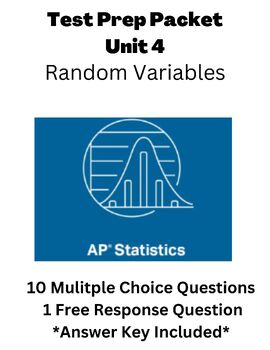AP Statistics- Discrete and Continuous Random Variable Practice
Miller Math Made Easy
6 Followers
Grade Levels
9th - 12th
Subjects
Resource Type
Standards
CCSSHSS-MD.A.1
CCSSHSS-MD.A.2
CCSSHSS-MD.A.3
CCSSHSS-MD.A.4
CCSSHSS-MD.B.5
Formats Included
- Word Document File
Pages
6 pages
Miller Math Made Easy
6 Followers
Description
**All questions in this document are NEW and solutions cannot be googled**
(as of this post on 6/6/23)
Test-prep practice directly aligned to College Board's CED for AP Statistics. This packet contains 10 multiple choice questions and 1 free response question, in addition to an answer key. The content covered in this packet includes practice on discrete and continuous random variables, with focus on finding expecting values, standard deviation, combining variables, transforming variables, and using a normal approximation to find probabilities. The download is an editable word document.
This document would be great to use as review for the AP exam, a quiz/test, or at-home practice.
Total Pages
6 pages
Answer Key
Included
Teaching Duration
90 minutes
Last updated Jun 6th, 2023
Report this resource to TPT
Reported resources will be reviewed by our team. Report this resource to let us know if this resource violates TPT’s content guidelines.
Standards
to see state-specific standards (only available in the US).
CCSSHSS-MD.A.1
Define a random variable for a quantity of interest by assigning a numerical value to each event in a sample space; graph the corresponding probability distribution using the same graphical displays as for data distributions.
CCSSHSS-MD.A.2
Calculate the expected value of a random variable; interpret it as the mean of the probability distribution.
CCSSHSS-MD.A.3
Develop a probability distribution for a random variable defined for a sample space in which theoretical probabilities can be calculated; find the expected value. For example, find the theoretical probability distribution for the number of correct answers obtained by guessing on all five questions of a multiple-choice test where each question has four choices, and find the expected grade under various grading schemes.
CCSSHSS-MD.A.4
Develop a probability distribution for a random variable defined for a sample space in which probabilities are assigned empirically; find the expected value. For example, find a current data distribution on the number of TV sets per household in the United States, and calculate the expected number of sets per household. How many TV sets would you expect to find in 100 randomly selected households?
CCSSHSS-MD.B.5
Weigh the possible outcomes of a decision by assigning probabilities to payoff values and finding expected values.




